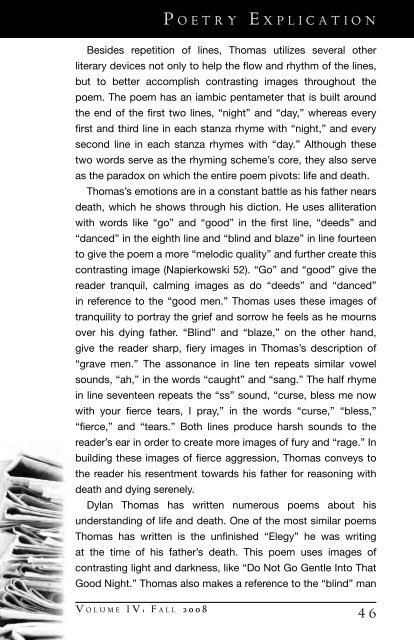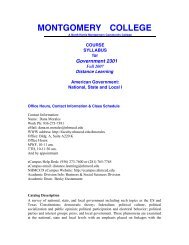2008 - Communication Across the Curriculum (CAC)
2008 - Communication Across the Curriculum (CAC)
2008 - Communication Across the Curriculum (CAC)
Create successful ePaper yourself
Turn your PDF publications into a flip-book with our unique Google optimized e-Paper software.
P o e t r y E x p l i c a t i o n<br />
Besides repetition of lines, Thomas utilizes several o<strong>the</strong>r<br />
literary devices not only to help <strong>the</strong> flow and rhythm of <strong>the</strong> lines,<br />
but to better accomplish contrasting images throughout <strong>the</strong><br />
poem. The poem has an iambic pentameter that is built around<br />
<strong>the</strong> end of <strong>the</strong> first two lines, “night” and “day,” whereas every<br />
first and third line in each stanza rhyme with “night,” and every<br />
second line in each stanza rhymes with “day.” Although <strong>the</strong>se<br />
two words serve as <strong>the</strong> rhyming scheme’s core, <strong>the</strong>y also serve<br />
as <strong>the</strong> paradox on which <strong>the</strong> entire poem pivots: life and death.<br />
Thomas’s emotions are in a constant battle as his fa<strong>the</strong>r nears<br />
death, which he shows through his diction. He uses alliteration<br />
with words like “go” and “good” in <strong>the</strong> first line, “deeds” and<br />
“danced” in <strong>the</strong> eighth line and “blind and blaze” in line fourteen<br />
to give <strong>the</strong> poem a more “melodic quality” and fur<strong>the</strong>r create this<br />
contrasting image (Napierkowski 52). “Go” and “good” give <strong>the</strong><br />
reader tranquil, calming images as do “deeds” and “danced”<br />
in reference to <strong>the</strong> “good men.” Thomas uses <strong>the</strong>se images of<br />
tranquility to portray <strong>the</strong> grief and sorrow he feels as he mourns<br />
over his dying fa<strong>the</strong>r. “Blind” and “blaze,” on <strong>the</strong> o<strong>the</strong>r hand,<br />
give <strong>the</strong> reader sharp, fiery images in Thomas’s description of<br />
“grave men.” The assonance in line ten repeats similar vowel<br />
sounds, “ah,” in <strong>the</strong> words “caught” and “sang.” The half rhyme<br />
in line seventeen repeats <strong>the</strong> “ss” sound, “curse, bless me now<br />
with your fierce tears, I pray,” in <strong>the</strong> words “curse,” “bless,”<br />
“fierce,” and “tears.” Both lines produce harsh sounds to <strong>the</strong><br />
reader’s ear in order to create more images of fury and “rage.” In<br />
building <strong>the</strong>se images of fierce aggression, Thomas conveys to<br />
<strong>the</strong> reader his resentment towards his fa<strong>the</strong>r for reasoning with<br />
death and dying serenely.<br />
Dylan Thomas has written numerous poems about his<br />
understanding of life and death. One of <strong>the</strong> most similar poems<br />
Thomas has written is <strong>the</strong> unfinished “Elegy” he was writing<br />
at <strong>the</strong> time of his fa<strong>the</strong>r’s death. This poem uses images of<br />
contrasting light and darkness, like “Do Not Go Gentle Into That<br />
Good Night.” Thomas also makes a reference to <strong>the</strong> “blind” man<br />
V o l u m e I V : F a l l 2 0 0 8<br />
4 6






